The recordings made by Christoph Heeman and Achim Flaam as HirscheNichts Auf Sofa has an appealingly built-in obsolescence. The bulk ofthe original catalog was released in small cassette and vinyl editionson Germany's DOM records, and with the exception of the five LPsrecently re-released in deluxe CD editions, most of the music remainsextremely scarce, making it great fodder for obsessive collectors.Unfortunately, many HNAS-related satellite projects such as MiesesGegonge, Duka Bass Band and Speck Nusseck have remained unreleased andlargely ignored. Recently G. Gonge Produktionen released this series ofCD-Rs, issuing six of the rarest DOM cassettes. Be warned: these discsare unofficial bootlegs, the original recordings have not beendigitally remastered, there are no bonus tracks and the packagingconsists of xeroxes of the original tape sleeves. Despite theselimitations, it's great to be able to hear the music again for thefirst time. Listening to these recordings 20 years after makes menostalgic for a lost age when esoteric and experimental underground DIYcassette labels flourished, not yet having been rendered obsolete bythe digital revolution. Creeping into this world of throwaway musiqueconcrete, off-kilter improvisation and drug-addled musical in-jokes islike rummaging through the dusty attic of a 90-year-old schizophrenicwho obsessively saves everything; it's a series of clues with nosolution, flashes of momentary inspiration and frustratingly stillbornideas. In short, the stuff of life.
MIESES GEGONGE, "LIVE" 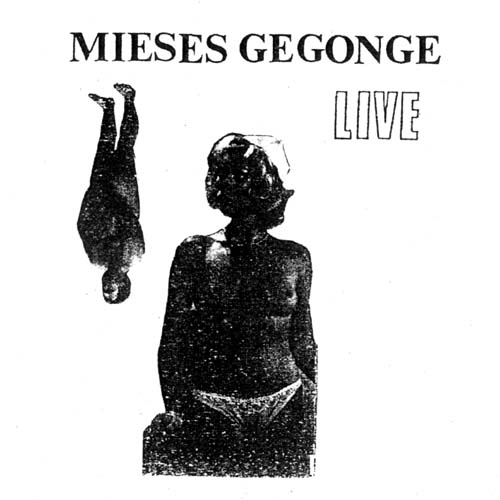 Mieses Gegonge are something of a mystery, but they appear to be asister group to HNAS, having shared the credit for the first HNAS albumAbwassermusik. The material on this CD is culled from two liveperformances in 1985. The sound is very strange indeed: a twistedcombination of arrhythmic percussion together with horribly phased anddistorted vocals. The treated voices and drums are immediatelyreminiscent of the "psych-out" sections of classic Can constructionslike "Halleluwah" and "Aumgn." However, Mieses Gegonge is all psych-outwith no breaks for coherence. Bizarre chants and ululations quaver andripple across layers of randomly beaten skins and gongs, reverbed andwarped into oblivion. If anyone attending these performances wasn't onat least three hits of fine Dusseldorf acid, I feel sorry for them. Therecording is shitty and wracked with distortion, which adds interestingbursts of high-frequency noise that contribute to the lunacy. Imagine apost-lobotomy 23 Skidoo trying to cover The Master Musicians of Jajoukawith nothing but a saw and a zither and William Bennett playing oneroom over, and you might begin to approximate the experience of Live.It's a uniquely fucked sound that will appeal to jaded listenerslooking for a surreal thrill.
Mieses Gegonge are something of a mystery, but they appear to be asister group to HNAS, having shared the credit for the first HNAS albumAbwassermusik. The material on this CD is culled from two liveperformances in 1985. The sound is very strange indeed: a twistedcombination of arrhythmic percussion together with horribly phased anddistorted vocals. The treated voices and drums are immediatelyreminiscent of the "psych-out" sections of classic Can constructionslike "Halleluwah" and "Aumgn." However, Mieses Gegonge is all psych-outwith no breaks for coherence. Bizarre chants and ululations quaver andripple across layers of randomly beaten skins and gongs, reverbed andwarped into oblivion. If anyone attending these performances wasn't onat least three hits of fine Dusseldorf acid, I feel sorry for them. Therecording is shitty and wracked with distortion, which adds interestingbursts of high-frequency noise that contribute to the lunacy. Imagine apost-lobotomy 23 Skidoo trying to cover The Master Musicians of Jajoukawith nothing but a saw and a zither and William Bennett playing oneroom over, and you might begin to approximate the experience of Live.It's a uniquely fucked sound that will appeal to jaded listenerslooking for a surreal thrill.
samples:
DUKA BASS BAND, "FRAULEIN CASANOVA"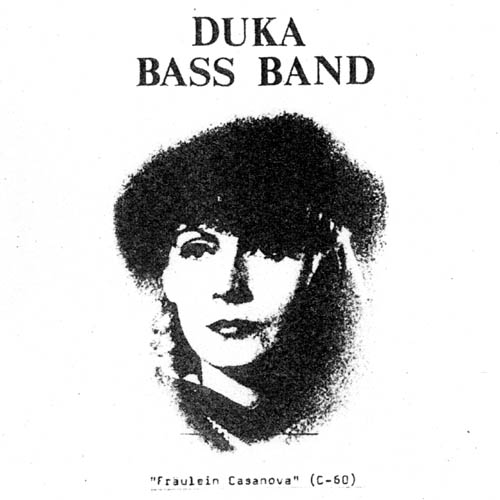 Duka Bass Band appears to be a trio consisting of Lasse Laudrup, Martin B. Klaeren and Sven Nykvist. On Fraulein Casanova,they are joined on a few tracks by Christoph Heeman and Achim P. LiKhan of HNAS, and Heeman also produced the album. The Duka Bass Band'ssound is a fuzzy, primitive clamor of clueless post-jazz improvisationsthat meander aimlessly and appear to fly in several differentdirections at once. It has a certain amateurish quality and a creepysubterranean feel that appeals to me, although I couldn't say exactlywhy. In the exclusively German liner notes, Heeman muses "Fraulein Casanovais for me a jerking step forward into the natural alreadyness ofmusic." Perhaps this dodgy AltaVista translation should not be trusted,but it's as good an explanation as any for the oddly surreal freeplaying on display here. The opening track is the seven-minute"Zauberformeln," which means 'magical formulas.' It's an aptdescription for the mysterious forces that transform the sound ofdeficiently played clarinet, organs and drums into a strange alchemicalgold that is more than the sum of its components. There are momentsthroughout Fraulein Casanova that touch on elements of firemusic improvs, belabored Shaggs-style guitar, and in the case of thelast track (whose title loosely translates to "For God, 1000 Years IsLike a Day"), a ramshackle psych-folk jam not dissimilar from therecent work of Sunburned Hand of the Man. This is my personal favoriteof the six bootlegs, and I look forward to further recordings by thismysterious post-industrial jazz trio materializing at some future point.
Duka Bass Band appears to be a trio consisting of Lasse Laudrup, Martin B. Klaeren and Sven Nykvist. On Fraulein Casanova,they are joined on a few tracks by Christoph Heeman and Achim P. LiKhan of HNAS, and Heeman also produced the album. The Duka Bass Band'ssound is a fuzzy, primitive clamor of clueless post-jazz improvisationsthat meander aimlessly and appear to fly in several differentdirections at once. It has a certain amateurish quality and a creepysubterranean feel that appeals to me, although I couldn't say exactlywhy. In the exclusively German liner notes, Heeman muses "Fraulein Casanovais for me a jerking step forward into the natural alreadyness ofmusic." Perhaps this dodgy AltaVista translation should not be trusted,but it's as good an explanation as any for the oddly surreal freeplaying on display here. The opening track is the seven-minute"Zauberformeln," which means 'magical formulas.' It's an aptdescription for the mysterious forces that transform the sound ofdeficiently played clarinet, organs and drums into a strange alchemicalgold that is more than the sum of its components. There are momentsthroughout Fraulein Casanova that touch on elements of firemusic improvs, belabored Shaggs-style guitar, and in the case of thelast track (whose title loosely translates to "For God, 1000 Years IsLike a Day"), a ramshackle psych-folk jam not dissimilar from therecent work of Sunburned Hand of the Man. This is my personal favoriteof the six bootlegs, and I look forward to further recordings by thismysterious post-industrial jazz trio materializing at some future point.
samples:
SPECK NUSSECK & DIE LEGENDAREN FETTBOYS, "DANCEMUSIC FUR DICKE BACKER"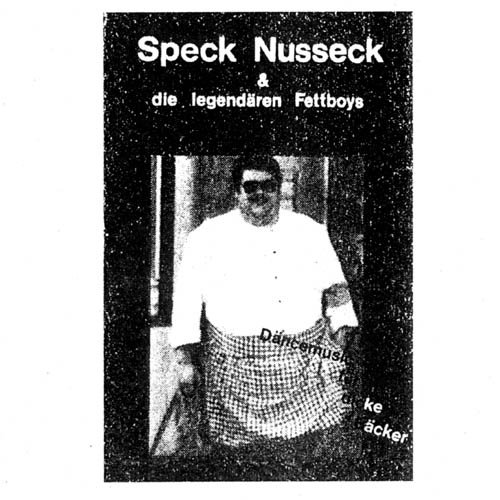 It's anyone's guess who the hell Speck Nusseck or The Legendary FatBoys are, or where they come from, or what masochistic weirdoencouraged them to record Dancemusic Fur Dicke Backer.The answers to these questions are not readily apparent, and they maynever become clear. The only thing we have to go on are the seven songscomprising Dancemusic, for which the word "annoying" seemswoefully inadequate. Plodding drum machine rhythms and randomly pluckedbass compete with vocals shouted into a megaphone backed by lamekeyboard effects which underscore the mess. I'm tempted to call thisoutsider music, but that would suggest that it is charmingly sincereand/or amateurish music that has worthwhile elements. Unfortunately,Speck Nusseck are neither charming nor sincere, and they are not worthanyone's time. They appear to be influenced by the edgy post-punk ofSection 25, the noisy effrontery of Throbbing Gristle and even themotorik beats of Neu!, but they are terribly unequal to the job ofpaying homage to their heroes. The best thing that can be said aboutthis album is that it is mercifully short, and would likely make anexcellent way to get rid of the last few people still hanging out inyour living room after the party is over.
It's anyone's guess who the hell Speck Nusseck or The Legendary FatBoys are, or where they come from, or what masochistic weirdoencouraged them to record Dancemusic Fur Dicke Backer.The answers to these questions are not readily apparent, and they maynever become clear. The only thing we have to go on are the seven songscomprising Dancemusic, for which the word "annoying" seemswoefully inadequate. Plodding drum machine rhythms and randomly pluckedbass compete with vocals shouted into a megaphone backed by lamekeyboard effects which underscore the mess. I'm tempted to call thisoutsider music, but that would suggest that it is charmingly sincereand/or amateurish music that has worthwhile elements. Unfortunately,Speck Nusseck are neither charming nor sincere, and they are not worthanyone's time. They appear to be influenced by the edgy post-punk ofSection 25, the noisy effrontery of Throbbing Gristle and even themotorik beats of Neu!, but they are terribly unequal to the job ofpaying homage to their heroes. The best thing that can be said aboutthis album is that it is mercifully short, and would likely make anexcellent way to get rid of the last few people still hanging out inyour living room after the party is over.
samples:
HNAS, "ICH KANNTE EINEN GUMMIBAUM"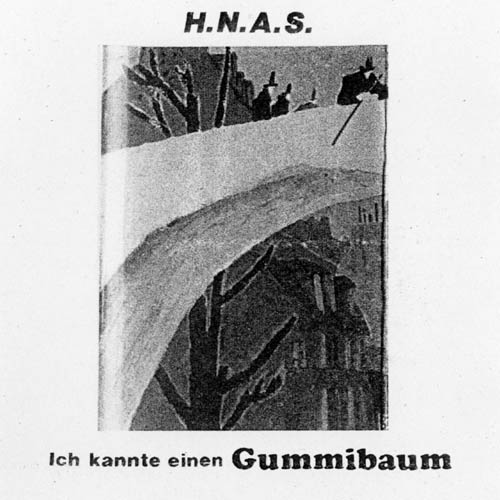 HNAS are invariably compared to Nurse With Wound, and more often thannot to the detriment of Heeman and company. It seems that they areforever doomed, relegated to an obscure footnote in the NWW story bywriters and critics, who seem unable to realize that HNAS use their ownunique strategies to portray their particular brand of audiosurrealism. HNAS does not revel in the exaggerated psychedelicgrotesqueries of Steven Stapleton's work — their tactics are sloppier,less calculated, and in many cases even stranger. The seminal krautrockband Faust is a much more analogous comparison. Heeman and Khan's pathwas paved by Faust's willfully messy LPs that cycled through disparatehalf-formed musical ideas and random piss-takes. Ich Kannte Einen Gummibaumis a good demonstration of their distinct sound. The first trackcreates a creeping quasi-rhythmic industrial atmosphere, recalling theearly work of Laibach, but Heeman's deliberately muddy production andmuffled sounds of voices, distant guitar solos and graveyard organs adda nebulous mystery belonging to HNAS alone. The second track, "Kill DenAchim" is culled from a live performance, and finds the band in agloriously anarchic phase. A woman screams violent provocations backedby oblivious, repetitive electric guitar licks and sheets of live noiseand distortion. On "Ich bin ja besser," a disco record is obscured bylayers of cacophonous whalesong. Track five loosely translates to "AWinter Without Skin Problems," in which a disintegrating chamberorchestra fights against encroaching electronic squalls. The last trackis an extended 25-minute construction combining silly-cum-sinistervocal mutations alongside nonsense percussion. The lunacy segues into alengthy section of concrete tape edits, combining impressionistic pianopieces with field recordings and samples drawn from German televisionand radio.
HNAS are invariably compared to Nurse With Wound, and more often thannot to the detriment of Heeman and company. It seems that they areforever doomed, relegated to an obscure footnote in the NWW story bywriters and critics, who seem unable to realize that HNAS use their ownunique strategies to portray their particular brand of audiosurrealism. HNAS does not revel in the exaggerated psychedelicgrotesqueries of Steven Stapleton's work — their tactics are sloppier,less calculated, and in many cases even stranger. The seminal krautrockband Faust is a much more analogous comparison. Heeman and Khan's pathwas paved by Faust's willfully messy LPs that cycled through disparatehalf-formed musical ideas and random piss-takes. Ich Kannte Einen Gummibaumis a good demonstration of their distinct sound. The first trackcreates a creeping quasi-rhythmic industrial atmosphere, recalling theearly work of Laibach, but Heeman's deliberately muddy production andmuffled sounds of voices, distant guitar solos and graveyard organs adda nebulous mystery belonging to HNAS alone. The second track, "Kill DenAchim" is culled from a live performance, and finds the band in agloriously anarchic phase. A woman screams violent provocations backedby oblivious, repetitive electric guitar licks and sheets of live noiseand distortion. On "Ich bin ja besser," a disco record is obscured bylayers of cacophonous whalesong. Track five loosely translates to "AWinter Without Skin Problems," in which a disintegrating chamberorchestra fights against encroaching electronic squalls. The last trackis an extended 25-minute construction combining silly-cum-sinistervocal mutations alongside nonsense percussion. The lunacy segues into alengthy section of concrete tape edits, combining impressionistic pianopieces with field recordings and samples drawn from German televisionand radio.
samples:
HNAS, "THE UNCOLLECTED ULTRA RARE & UNRELEASED"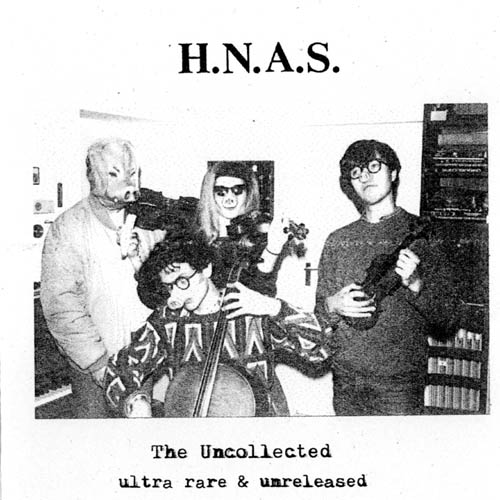 Another in a trilogy of rare HNAS cassette titles issued by G. Gonge, The Uncollectedis an odds-and-sods anthology, collecting tracks from out-of-printcompilations and rare cassettes, as well as some previously unreleasedmaterial. As such it is an uneven and incoherent listen, but with aband as unorthodox as HNAS, that's hardly a problem. Most of the tracksare in the jagged cut-and-splice style recognizable from mid-80's HNASalbums. It feels a bit like an audio version of the absurdist photo andtext collages found in early punk zines. More than once these piecesdigress into the stoned chatter and laughter of a group of youngGermans, who I can only assume to be Christoph, Achim, and friends.Recording and including this unseemly screwing-about on their albumstakes the music out of the realm of the dryly conceptual oravant-garde, and into the "anything goes" realm of DIY homeexperimentalism. That said, there is also much that is musicallyimpressive among these songs, as in the noir queasiness of "DemPetermann zu Ehren," a dark piano dirge. "Was wir von Cassetten halten4" is a phased electronic piece with looped sing-song vocals recallsearly Current 93. "Wie ein Bock am Michekstag" is similar to the workPeople Like Us, juxtaposing dialogue samples from a "Learn to SpeakSwedish" tape with a kitschy exotica loop. The final song is a rare andlovely track by Duka Bass Band: more demented post-jazz with sinisterundertones.
Another in a trilogy of rare HNAS cassette titles issued by G. Gonge, The Uncollectedis an odds-and-sods anthology, collecting tracks from out-of-printcompilations and rare cassettes, as well as some previously unreleasedmaterial. As such it is an uneven and incoherent listen, but with aband as unorthodox as HNAS, that's hardly a problem. Most of the tracksare in the jagged cut-and-splice style recognizable from mid-80's HNASalbums. It feels a bit like an audio version of the absurdist photo andtext collages found in early punk zines. More than once these piecesdigress into the stoned chatter and laughter of a group of youngGermans, who I can only assume to be Christoph, Achim, and friends.Recording and including this unseemly screwing-about on their albumstakes the music out of the realm of the dryly conceptual oravant-garde, and into the "anything goes" realm of DIY homeexperimentalism. That said, there is also much that is musicallyimpressive among these songs, as in the noir queasiness of "DemPetermann zu Ehren," a dark piano dirge. "Was wir von Cassetten halten4" is a phased electronic piece with looped sing-song vocals recallsearly Current 93. "Wie ein Bock am Michekstag" is similar to the workPeople Like Us, juxtaposing dialogue samples from a "Learn to SpeakSwedish" tape with a kitschy exotica loop. The final song is a rare andlovely track by Duka Bass Band: more demented post-jazz with sinisterundertones.
samples:
HNAS, "DIE DREHORGEL ALS FEUERSPRITZE"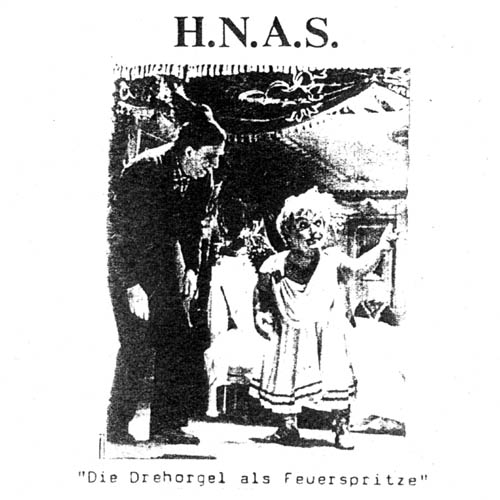 The first track of Die Drehorgel Als Feuerspritzewas recorded live in 1984, the title roughly translating to "TheParadoxes and Secret Sciences of the World." It's one of the bestpieces I've heard HNAS' prolific oevre, a murky sound sculpturecomprising long-form synth drones and gothic organ swells. The sticky,shapeless drones and burbling moogs converge into caverns filled withfloating stone obelisks that chisel strange patterns into thelistener's consciousness. The piece develops using an interior logic, adreamlike coherence that slowly asserts itself over the course of halfan hour. "Barenklammer" was recorded for an as-yet-unreleased HNASvideo, and contains some of the same source material as the firsttrack, quite reminiscent of the synthesizer arpeggiations andavant-rock noise that characterized Tangerine Dream's Electronic Meditationalbum. The third track pushes my PANIC buttons: a manipulative noisepiece that plays like Bernard Herrmann's string tribute to Whitehouse.The layered voices and random bass slaps of the last track evokes Crasscovering a Hildegaard von Bingen chant while tripping on mushrooms.This is a concentrated effort by HNAS, and its single-minded absurditymakes it the most consistent of the three HNAS CD-Rs reissued by G.Gonge. As more of these rare recordings come to light, perhaps HNAS canfinally crawl out of the long shadow cast by Nurse With Wound andreveal themselves to be every bit as unique, talented and vital.
The first track of Die Drehorgel Als Feuerspritzewas recorded live in 1984, the title roughly translating to "TheParadoxes and Secret Sciences of the World." It's one of the bestpieces I've heard HNAS' prolific oevre, a murky sound sculpturecomprising long-form synth drones and gothic organ swells. The sticky,shapeless drones and burbling moogs converge into caverns filled withfloating stone obelisks that chisel strange patterns into thelistener's consciousness. The piece develops using an interior logic, adreamlike coherence that slowly asserts itself over the course of halfan hour. "Barenklammer" was recorded for an as-yet-unreleased HNASvideo, and contains some of the same source material as the firsttrack, quite reminiscent of the synthesizer arpeggiations andavant-rock noise that characterized Tangerine Dream's Electronic Meditationalbum. The third track pushes my PANIC buttons: a manipulative noisepiece that plays like Bernard Herrmann's string tribute to Whitehouse.The layered voices and random bass slaps of the last track evokes Crasscovering a Hildegaard von Bingen chant while tripping on mushrooms.This is a concentrated effort by HNAS, and its single-minded absurditymakes it the most consistent of the three HNAS CD-Rs reissued by G.Gonge. As more of these rare recordings come to light, perhaps HNAS canfinally crawl out of the long shadow cast by Nurse With Wound andreveal themselves to be every bit as unique, talented and vital.
samples:


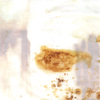 Jim Haynes is a San Francisco-based musician who has made a name for himself through work in the duo Coelacanth and in his travels as a solo sound-artist. The rich SF scene has no doubt provided Haynes with many opportunities to expand his listener-ship, and recently he has ventured eastward with an installation called Magnetic North appearing in Nashville and San Jose. This disc, the first release from The Helen Scarsdale Agency and limited to 300 copies, contains the audio portion of the installation, culled from performances of the last two years. The most striking quality of the music herein can inadequately be described as its organic nature.
Jim Haynes is a San Francisco-based musician who has made a name for himself through work in the duo Coelacanth and in his travels as a solo sound-artist. The rich SF scene has no doubt provided Haynes with many opportunities to expand his listener-ship, and recently he has ventured eastward with an installation called Magnetic North appearing in Nashville and San Jose. This disc, the first release from The Helen Scarsdale Agency and limited to 300 copies, contains the audio portion of the installation, culled from performances of the last two years. The most striking quality of the music herein can inadequately be described as its organic nature.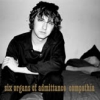 Ben Chasny, aka Six Organs of Admittance, has been crafting his brand of acoustic rock for the past five years, winning some over with his psychedelic ruminations and earthy tones. For his latest release, the pop song structure is on full display, as Chasny keeps it short and sweet for the most part, and lays on the space rock undertone with a very thin brush. As always, Chasny plays pretty much everything himself, with Ethan Miller adding the most influential contributions. There seems to be a more Indian influence on these songs than there ever was before, from the opening track to the sitar on "Somewhere Between," though Chasny's guitar work is everywhere and as impressive as always. Six Organs' infamous lack of production values are also on every track, with the whole album possessing a muted, dirty, and quirky quality, where tempos speed up and slow down here and there, and sounds swell in and out. Chasny's multi-tracked vocals have a spooky effect, like a ghost choir with little to live for, and as each track progresses, he takes greater chances and reaches to new highs and lows with his voice. Altogether this means it's more of the same from Chasny for the most part, with nothing really shocking or new to speak of. That's not necessarily a bad thing, as the songs are among the best he's written, including the "reworked and finalized" version of "Somewhere Between;" but it still leaves me with that overwhelming feeling of "What if he...?" Someday, maybe Six Organs will branch out into new territory. Until then, there's still a lot to appreciate, as acoustic psychedelia doesn't get much better than this.
Ben Chasny, aka Six Organs of Admittance, has been crafting his brand of acoustic rock for the past five years, winning some over with his psychedelic ruminations and earthy tones. For his latest release, the pop song structure is on full display, as Chasny keeps it short and sweet for the most part, and lays on the space rock undertone with a very thin brush. As always, Chasny plays pretty much everything himself, with Ethan Miller adding the most influential contributions. There seems to be a more Indian influence on these songs than there ever was before, from the opening track to the sitar on "Somewhere Between," though Chasny's guitar work is everywhere and as impressive as always. Six Organs' infamous lack of production values are also on every track, with the whole album possessing a muted, dirty, and quirky quality, where tempos speed up and slow down here and there, and sounds swell in and out. Chasny's multi-tracked vocals have a spooky effect, like a ghost choir with little to live for, and as each track progresses, he takes greater chances and reaches to new highs and lows with his voice. Altogether this means it's more of the same from Chasny for the most part, with nothing really shocking or new to speak of. That's not necessarily a bad thing, as the songs are among the best he's written, including the "reworked and finalized" version of "Somewhere Between;" but it still leaves me with that overwhelming feeling of "What if he...?" Someday, maybe Six Organs will branch out into new territory. Until then, there's still a lot to appreciate, as acoustic psychedelia doesn't get much better than this. 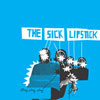 It's not as easy as it seems to be noisy. There's more to it than justyelling and banging on an instrument. It takes some real premeditationand skill to be able to pull together a rush of ear-piercing sound intosomething that is abrasive while still inspiring curiosity in thelistener to delve into the depth of the sound. The Sick Lipstick findthemselves on the right side of the line between trash and treasure,dropping an album that is assaulting in its style and modus operandibut is more likely to make the listener flail about with recklessabandon than hide under the bed. Lead vocalist Lindsay Gillard poutsand struts throughout, hurling deliciously shrill invectives ofnonsensical, stream-of-conscious lyrics into the band's swirl of noiseand atonality. She sounds like the spoiled girl who didn't get her wayfor once and unleashes a level of anger and psychological torture wellbeyond her years. She's got a knack for turning a phrase and catchingthe attention with lyrics like "I want / to have / your baby! / So youhave / to come / inside me!" from "Pretend I'm Sleeping," delivered inher elementary schoolgirl tone. Even when the song's subject matterisn't explicitly nasty or violent, Dillard's phrasing and tone are verypointed, and at time disturbing like the macabre, playground taunts ofa budding sociopath who just won't stop knocking the other kids aroundduring an otherwise pleasant game of kickball. Musically, The SickLipstick slug it out with razorblade guitar licks that jerk and squealrecklessly. These licks often skid out of control into waves of whitenoise that undulate wildly, creating a harsh auditory burnout. Backedwith a chunky, fuzzy keyboard they create a remarkably consistent soundfor a band whose aesthetic is so rooted in chaotic intensity. Thepercussion maintains a pleasant bi-polarity, at once both relentlesslynoisy and eagerly danceable. "Mommy's at the Grocery Store" benefitsfrom a modulating riff that repeats rhythmically with the backbeat andmakes it a positively brutal earworm, and the cascading, declarativechorus of "Zombie Cookie" seems destined to be some kind of alternatereality cheerleading cheer. "Thigh Master, I'm Yr Master" is thesurrealist-feminist rant that Kathleen Hanna wishes she wrote, jumpingfrom image to image in a jittery pounce. While their sound isinteresting and decidedly catchy, they rarely emerge from theboundaries established in the first few songs. Their tightness andcontrol keeps them from losing shape. Gillard never outright screams ina wordless fury, and the accompaniment never explodes into thefree-rock explosion that the building tension on Sting, Sting, Stingseems to foreshadow. That might be a difficult goal for the band toreach however, since every song on the album already kicks off at fullpower and never lets up. While the fervor this conveys is exhilaratingand exciting, a foray into more noticeable dynamics and counterpointsmight make those peaks even higher. In spite of these unfulfilleddesires, what The Sick Lipstick does present us with is a screechingbanshee punk rock record with provocative personality and loads of darkfun.
It's not as easy as it seems to be noisy. There's more to it than justyelling and banging on an instrument. It takes some real premeditationand skill to be able to pull together a rush of ear-piercing sound intosomething that is abrasive while still inspiring curiosity in thelistener to delve into the depth of the sound. The Sick Lipstick findthemselves on the right side of the line between trash and treasure,dropping an album that is assaulting in its style and modus operandibut is more likely to make the listener flail about with recklessabandon than hide under the bed. Lead vocalist Lindsay Gillard poutsand struts throughout, hurling deliciously shrill invectives ofnonsensical, stream-of-conscious lyrics into the band's swirl of noiseand atonality. She sounds like the spoiled girl who didn't get her wayfor once and unleashes a level of anger and psychological torture wellbeyond her years. She's got a knack for turning a phrase and catchingthe attention with lyrics like "I want / to have / your baby! / So youhave / to come / inside me!" from "Pretend I'm Sleeping," delivered inher elementary schoolgirl tone. Even when the song's subject matterisn't explicitly nasty or violent, Dillard's phrasing and tone are verypointed, and at time disturbing like the macabre, playground taunts ofa budding sociopath who just won't stop knocking the other kids aroundduring an otherwise pleasant game of kickball. Musically, The SickLipstick slug it out with razorblade guitar licks that jerk and squealrecklessly. These licks often skid out of control into waves of whitenoise that undulate wildly, creating a harsh auditory burnout. Backedwith a chunky, fuzzy keyboard they create a remarkably consistent soundfor a band whose aesthetic is so rooted in chaotic intensity. Thepercussion maintains a pleasant bi-polarity, at once both relentlesslynoisy and eagerly danceable. "Mommy's at the Grocery Store" benefitsfrom a modulating riff that repeats rhythmically with the backbeat andmakes it a positively brutal earworm, and the cascading, declarativechorus of "Zombie Cookie" seems destined to be some kind of alternatereality cheerleading cheer. "Thigh Master, I'm Yr Master" is thesurrealist-feminist rant that Kathleen Hanna wishes she wrote, jumpingfrom image to image in a jittery pounce. While their sound isinteresting and decidedly catchy, they rarely emerge from theboundaries established in the first few songs. Their tightness andcontrol keeps them from losing shape. Gillard never outright screams ina wordless fury, and the accompaniment never explodes into thefree-rock explosion that the building tension on Sting, Sting, Stingseems to foreshadow. That might be a difficult goal for the band toreach however, since every song on the album already kicks off at fullpower and never lets up. While the fervor this conveys is exhilaratingand exciting, a foray into more noticeable dynamics and counterpointsmight make those peaks even higher. In spite of these unfulfilleddesires, what The Sick Lipstick does present us with is a screechingbanshee punk rock record with provocative personality and loads of darkfun.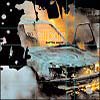 Here is another electronic, beat-based album that plays the game of "Ilove it/I hate it." The atmosphere is mostly dark, the beats thick andchugging, and the melodies somehow buried inside walls of static noiseand time-warped samples. There's the first problem: sometimes themelodies never get a chance to come out and play. As a result, I'm leftlistening to a somewhat boring, somewhat repetitive drum track thatdoesn't have the power to carry the song by itself. Unfortunately, thealbum is produced in such a way that each song inevitably has someincredible sounds on it but they're completely attenuated by the waythey're thrown into the backgroud and lost beneath a plethora ofeffects. But then, amazingly, all that wishy-washy noise comes togetherfor a few brief moments and gives birth to an explosion that comesclose to relieving the tension and weariness of the first few minutesof the song. This is how "Flesh Wound" opens up the album and it seguesinto the infinitely more entertaining "Gargantuan." I imagine one ofthose dolls that has a slinky for a neck bopping around to this rubberyand dynamic wall of beats only to have a stick of dynamite send it intothe great beyond. "Gargantuan" has nearly the same production style as"Flesh Wound," but manages to pull it off by allowing the repeatingdrum and melody patterns to weave a bit more intricate and diverse bodyof sound. "Boiled In Blood" is a bit more low-key than anything else onthe album and it provides a nice break from the havoc of the first twotracks. It unfortunately gives way to more standard four-on-the-floordance music that sounds horribly distorted and only covers up whatseems to be the most interesting elements dying in the background. Andso this process continues throughout the duration of Don't Be Scared.I either love it or I hate it. Not much changes in terms of production:it's all pretty muddy and eventually this makes the entire album feelfar too homogenous. The formula either works for some of the songs orit doesn't. This up and down experience ends up making the whole albumfeel dull; it's just hard to sit down and listen to the whole thing allthe way through.
Here is another electronic, beat-based album that plays the game of "Ilove it/I hate it." The atmosphere is mostly dark, the beats thick andchugging, and the melodies somehow buried inside walls of static noiseand time-warped samples. There's the first problem: sometimes themelodies never get a chance to come out and play. As a result, I'm leftlistening to a somewhat boring, somewhat repetitive drum track thatdoesn't have the power to carry the song by itself. Unfortunately, thealbum is produced in such a way that each song inevitably has someincredible sounds on it but they're completely attenuated by the waythey're thrown into the backgroud and lost beneath a plethora ofeffects. But then, amazingly, all that wishy-washy noise comes togetherfor a few brief moments and gives birth to an explosion that comesclose to relieving the tension and weariness of the first few minutesof the song. This is how "Flesh Wound" opens up the album and it seguesinto the infinitely more entertaining "Gargantuan." I imagine one ofthose dolls that has a slinky for a neck bopping around to this rubberyand dynamic wall of beats only to have a stick of dynamite send it intothe great beyond. "Gargantuan" has nearly the same production style as"Flesh Wound," but manages to pull it off by allowing the repeatingdrum and melody patterns to weave a bit more intricate and diverse bodyof sound. "Boiled In Blood" is a bit more low-key than anything else onthe album and it provides a nice break from the havoc of the first twotracks. It unfortunately gives way to more standard four-on-the-floordance music that sounds horribly distorted and only covers up whatseems to be the most interesting elements dying in the background. Andso this process continues throughout the duration of Don't Be Scared.I either love it or I hate it. Not much changes in terms of production:it's all pretty muddy and eventually this makes the entire album feelfar too homogenous. The formula either works for some of the songs orit doesn't. This up and down experience ends up making the whole albumfeel dull; it's just hard to sit down and listen to the whole thing allthe way through.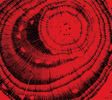
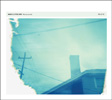
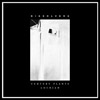
 As enjoyable as Robert Haigh's albums have been, they never seemed to capture that same aching beauty of his classic albums from the '80s (both under his own name and as Sema). This latest album changes all that. The delicate touch and fragile melodies, which defined his best work, are both present. Sombre without being dour, reflective without being depressing, this represents Haigh's finest work in years.
As enjoyable as Robert Haigh's albums have been, they never seemed to capture that same aching beauty of his classic albums from the '80s (both under his own name and as Sema). This latest album changes all that. The delicate touch and fragile melodies, which defined his best work, are both present. Sombre without being dour, reflective without being depressing, this represents Haigh's finest work in years.
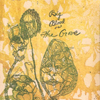
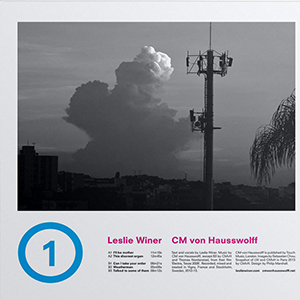 What began apparently as an unplanned collaboration between Leslie Winer's text and spoken word with CM von Hausswolff's electronics in 2011 eventually evolved into this full fledged LP release, also Winer's first all original release in 25 years. The result, (1), is a release that heavily strikes a balance between the two predominant elements, without one ever overshadowing the other. Winer’s idiosyncratic voice and artistically obtuse writing and von Hausswolff's understated use of electronics blend together wonderfully for this record.
What began apparently as an unplanned collaboration between Leslie Winer's text and spoken word with CM von Hausswolff's electronics in 2011 eventually evolved into this full fledged LP release, also Winer's first all original release in 25 years. The result, (1), is a release that heavily strikes a balance between the two predominant elements, without one ever overshadowing the other. Winer’s idiosyncratic voice and artistically obtuse writing and von Hausswolff's understated use of electronics blend together wonderfully for this record.
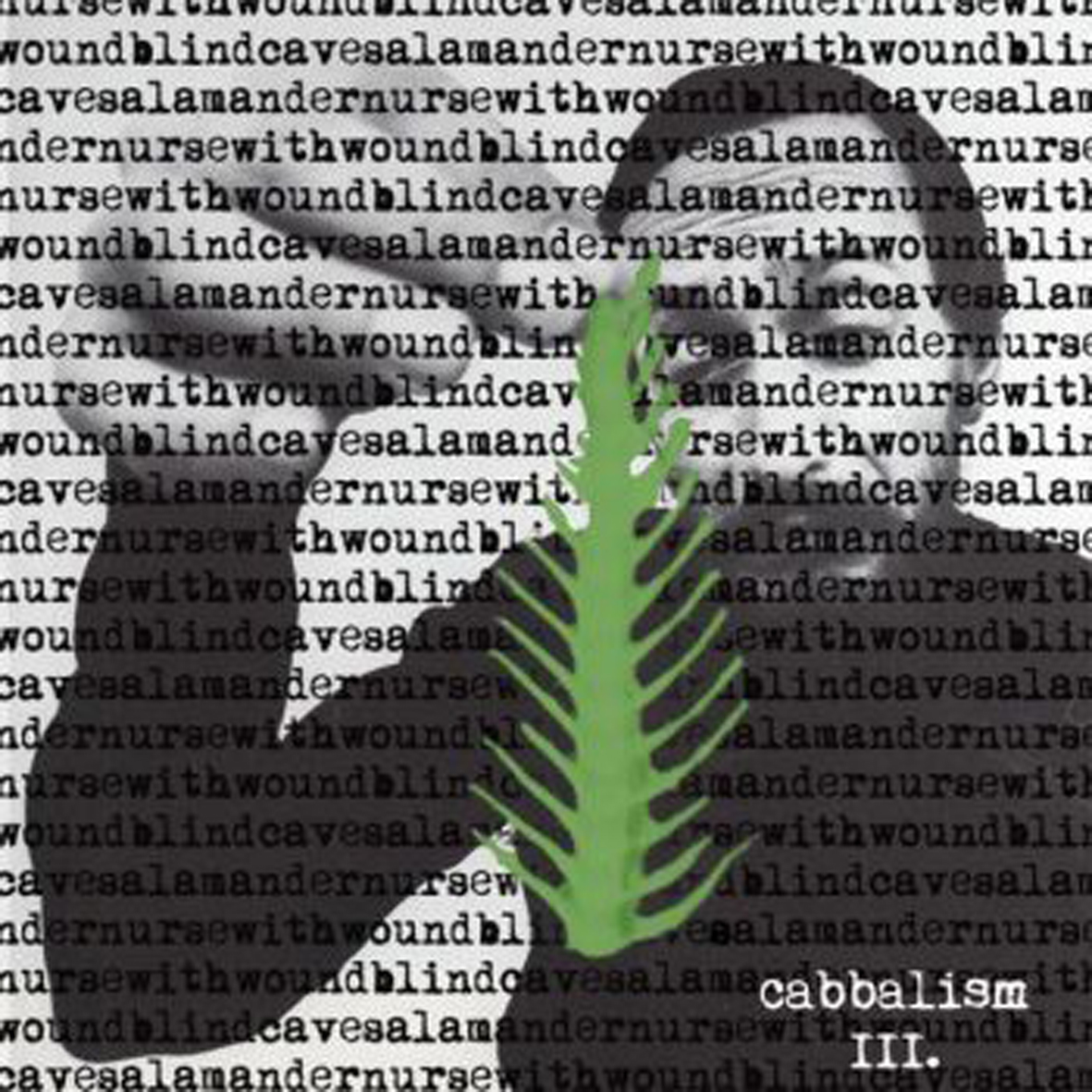 This is an expanded reissue of a 2012 album that documented two 2009 live performances in which Nurse With Wound, Julia Kent, and Italy’s Blind Cave Salamander teamed up for an improbable variation/reinterpretation of NWW’s classic Soliloquy for Lilith album (an album that was largely the product of an unexpected and unrepeatable electromagnetic phenomenon).  The expansion in question is a third performance in an identical vein to the previous two.  Notably, however, that vein is not all that much like Soliloquy, which makes Cabbalism something separate and singular rather than just a mere live album.  In fact, it does not even sound much like NWW at all, which I suppose makes this a very successful collaboration.  While the third piece is not nearly divergent enough to warrant repurchasing the album for anyone who pounced on Cabbalism this first time around, the reissue is a very enticing package for those of us who unwisely slept on it.
This is an expanded reissue of a 2012 album that documented two 2009 live performances in which Nurse With Wound, Julia Kent, and Italy’s Blind Cave Salamander teamed up for an improbable variation/reinterpretation of NWW’s classic Soliloquy for Lilith album (an album that was largely the product of an unexpected and unrepeatable electromagnetic phenomenon).  The expansion in question is a third performance in an identical vein to the previous two.  Notably, however, that vein is not all that much like Soliloquy, which makes Cabbalism something separate and singular rather than just a mere live album.  In fact, it does not even sound much like NWW at all, which I suppose makes this a very successful collaboration.  While the third piece is not nearly divergent enough to warrant repurchasing the album for anyone who pounced on Cabbalism this first time around, the reissue is a very enticing package for those of us who unwisely slept on it.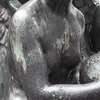 Clocking in at a meager 20 minutes, these two tracks mix ambience, noise, and traditional instrumentation into a fog that is sparse, yet complex, and has moments of arid beauty as well as dark, sinister passages. More than a few times this young composer reminded me of some of Organum's best moments, which is a massive compliment.
Clocking in at a meager 20 minutes, these two tracks mix ambience, noise, and traditional instrumentation into a fog that is sparse, yet complex, and has moments of arid beauty as well as dark, sinister passages. More than a few times this young composer reminded me of some of Organum's best moments, which is a massive compliment.
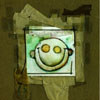 Now somewhere in the realms of prog/psych/metal/whatever, at one point Norway's Motopsycho were among the crop of potential "next big things" in a post-Nirvana world, creating music that wasn't far removed from the "alternative" scene that would soon be exploited and plundered to give us the likes of Nickleback and the existence of "nu-metal". Even then, however, there was a streak of weirdness that the band would later tap into more deeply, and on the double CD/triple LP Timothy's Monster, the band perfectly balanced catchy rock with bizarre outbursts. Long a cult favorite, this set reproduces the original album in its entirety (the US and UK versions edited the longer pieces to make it fit on a single disc), with an unreleased "first draft" of the album, and a disc full of outtakes/B-sides. It’s a lot to digest, but even for the casual fan, it's a strong set.
Now somewhere in the realms of prog/psych/metal/whatever, at one point Norway's Motopsycho were among the crop of potential "next big things" in a post-Nirvana world, creating music that wasn't far removed from the "alternative" scene that would soon be exploited and plundered to give us the likes of Nickleback and the existence of "nu-metal". Even then, however, there was a streak of weirdness that the band would later tap into more deeply, and on the double CD/triple LP Timothy's Monster, the band perfectly balanced catchy rock with bizarre outbursts. Long a cult favorite, this set reproduces the original album in its entirety (the US and UK versions edited the longer pieces to make it fit on a single disc), with an unreleased "first draft" of the album, and a disc full of outtakes/B-sides. It’s a lot to digest, but even for the casual fan, it's a strong set.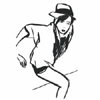 This hypnotic listening experience is as pleasantly soporific and gently gritty as if Mazzy Star had been produced by Alex Chilton.
This hypnotic listening experience is as pleasantly soporific and gently gritty as if Mazzy Star had been produced by Alex Chilton.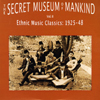 Before Sublime Frequencies began their plunge into the gritty and forgotten corners of global music, there was Pat Conte, a curmudgeonly postal employee and WFMU DJ from Long Island with a basement full of 78s. In the '90s, he curated an impressive series of rather unusual compilations named after an enigmatic and semi-legendary collection of photographs published in the 1930s. This is the second volume in the well-deserved vinyl reissue of the series and it is everything I could hope for: an achievement made even more remarkable by the fact that Conte had never traveled further than Canada when it was originally issued.
Before Sublime Frequencies began their plunge into the gritty and forgotten corners of global music, there was Pat Conte, a curmudgeonly postal employee and WFMU DJ from Long Island with a basement full of 78s. In the '90s, he curated an impressive series of rather unusual compilations named after an enigmatic and semi-legendary collection of photographs published in the 1930s. This is the second volume in the well-deserved vinyl reissue of the series and it is everything I could hope for: an achievement made even more remarkable by the fact that Conte had never traveled further than Canada when it was originally issued.

